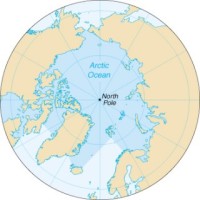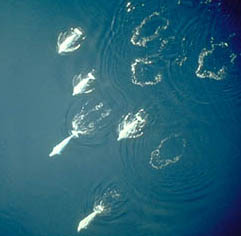A Whale Of A Tale!
 Belugas
never enter water that is warmer than 59° Fahrenheit.
Also, they are only located in the cold waters of the
North in the continuous band of waters around the North
Pole. Belugas inhabit
the Arctic Ocean areas along with other mammals like Killer
Whales, Humans and some other arctic fish. The Beluga's
distribution to the niche is
that it consumes a variety of
fish and organisms which allows for genetic variation among
the species and takes the weak or dying fish out of the
genetic pool. Belugas
never enter water that is warmer than 59° Fahrenheit.
Also, they are only located in the cold waters of the
North in the continuous band of waters around the North
Pole. Belugas inhabit
the Arctic Ocean areas along with other mammals like Killer
Whales, Humans and some other arctic fish. The Beluga's
distribution to the niche is
that it consumes a variety of
fish and organisms which allows for genetic variation among
the species and takes the weak or dying fish out of the
genetic pool.
*(Darker
Blue is the Beluga's Habitat)
(Predominant in arctic waters of USA/ Canada, Greenland,
Russia, Norway)
Busy, Busy Belugas
During the summer
months Belugas migrate to the North and during winter
months belugas migrate South, away from the ice and horribly
cold waters. They migrate at an
average for 2 miles an hour and can keep that pace for two
straight days. They gather in groups of between 100 and 200
belugas to migrate. The biggest threat during the winter times
are that if they do not migrate early enough they can become
trapped by the quickly forming ice. If such occurs there is
little possibility for them to survive. While trapped in the
ice pockets there is no way for the belugas to get enough air
or food and are easily killed by polar bears.
 Vacation!
-- Pod Of Migrating Belugas Vacation!
-- Pod Of Migrating Belugas
The summer grounds a lot of the time are freshwater outlets of
streams. Some researchers actually think that the wrinkles on
the Beluga's skin is because somehow it adapts to the
switching between the salt waters of the ocean to the
freshwater streams. The group can occupy the freshwater
outlets for hours or days but
some danger does occur from being in such shallow areas. Some
belugas may get caught in the falling tides and be stuck on
the shore. Severe dehydration and skin damage usually occurs
before the tide comes back up and they are able to swim off.
The Beluga has a mucus that secretes from their eyes when they
are stranded to keep their eyes moist, often looks like the
whale is crying. Usually the Beluga survives being stranded,
but if that situation were to occur it is their most
vulnerable time to predators.
Top Picture Provided By: CIA. The
World Factbook. (online).
Bottom Picture Provided By: NOAA.
(online).
|